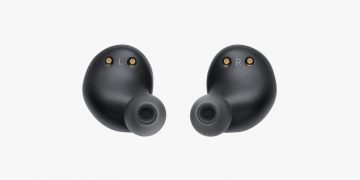There’s a lot to like about the $450 Samsung Galaxy Watch 5 Pro. Not only does it have all the trimmings of a smartwatch, but it adds extra sports functions that athletes may want — and for almost half the price of some other outdoor watches with similar construction like the $900 Garmin Epix 2. It also has a tougher design and bigger battery than the regular Galaxy Watch 5. Just don’t expect it to be a true outdoor watch that you can take on multi-day adventures, because the battery life isn’t as strong as the competition.
Like
- Good heart rate accuracy during workouts
- Wide selection of apps through the Play Store
- Battery lasts longer than Galaxy Watch 5
- Tough construction
Don’t Like
- Dim always-on display during outdoor workouts
- Skin temperature sensor not active yet
- Limited recovery metrics
- Only one 45mm size
Both the Galaxy Watch 5 and Galaxy Watch 5 Pro are Samsung’s second-gen Galaxy watches running Wear OS 3. Until we see the new Pixel Watch and a range of long-promised watches also on the new platform, they’re the best Android watches you can get.
But the Galaxy Watch 5 Pro only comes in one 45-millimeter case size, which might be too big for smaller wrists. Note that even though this is an Android watch, some of Samsung’s key health features require a Samsung phone to use.
Tough design with a bulky fit on the wrist
The Watch 5 Pro is more durable than the regular Galaxy Watch 5. It has a raised rim around the screen, titanium construction and stronger sapphire crystal glass on the screen. With an IP68 rating, it’s also dust- and water-resistant. While I haven’t deliberately dropped it or tried to scratch it, I’ve taken it on a dusty bike ride, scuffed it in sand at the beach and lifted weights that banged up against the watch. It still looks brand new, but only time will tell how it might stand up in tougher environments such as construction sites.
Lexy Savvides/CNET
It only comes in one 45mm size, which makes it more difficult for those with smaller wrists to wear, unlike the 40mm and 44mm options on the regular watch. I’ve worn larger watches before — the Garmin Epix 2 comes to mind, with its hefty 47mm frame. But for people with even smaller wrists than mine, it will probably be too big and possibly too heavy at 76 grams (2.6 ounces) with the included magnetic buckle strap. I’m disappointed that the watch’s bulky design will inherently limit its appeal. But the 1.4-inch AMOLED screen is bright, sharp and shows Wear OS (and Samsung’s One UI interface) in the best light.
Instead of a physical rotating bezel, the Galaxy Watch 5 Pro comes with a touch bezel that lets you navigate menus alongside the touchscreen and side buttons. It’s easier to use on the Watch 5 Pro compared to the regular Watch 5 because of the Pro’s raised edge. You can almost rest your finger against it as you “turn” the bezel. It’s still not as precise as having a physical bezel that clicks into place, especially if you have wet or sweaty hands — which seems inevitable if you’re really using this watch for its sports capabilities.
I can see why Samsung opted to remove the physical rotating bezel, given it’s another moving part that could potentially get damaged or jammed if you’re using this watch in tough environments. But I still miss having that option and feel Samsung could have made other compromises instead. For example, I could imagine using the inner rim of the raised edge as a small rotating bezel instead.
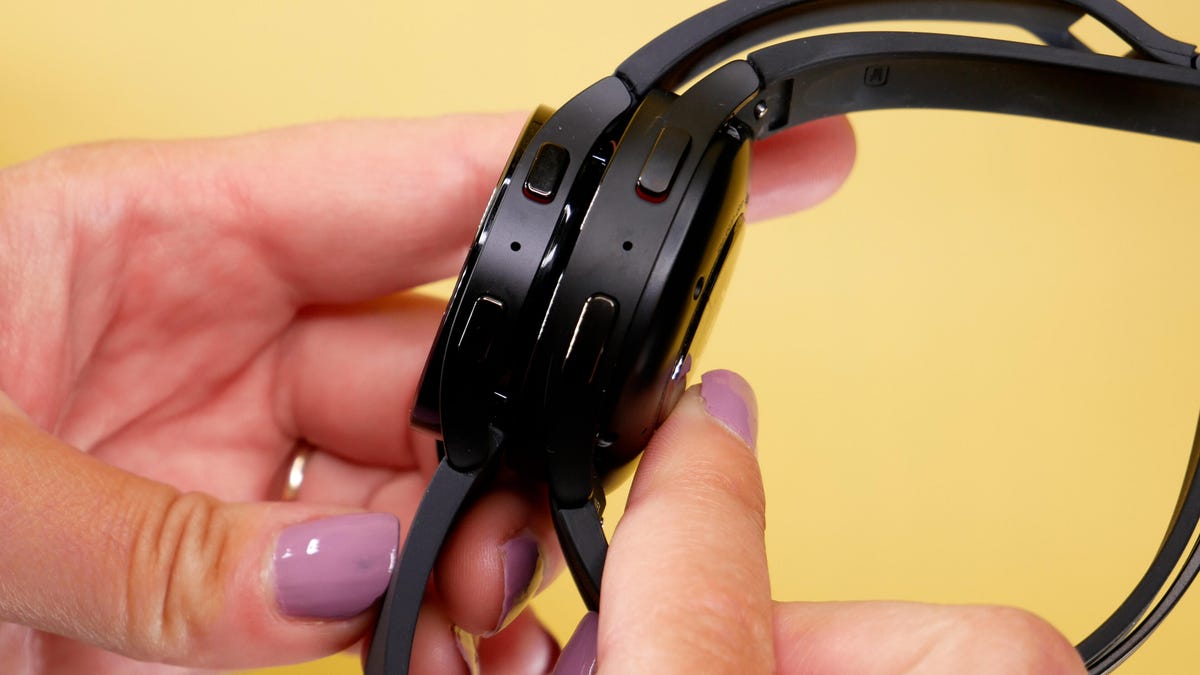
Thickness comparison between the Galaxy Watch 5 (left) and Pro (right).
Lexy Savvides/CNET
The Galaxy Watch 5 Pro uses the same processor as last year’s Galaxy Watch 4, rather than the new Qualcomm Snapdragon W5 chip. Performance is snappy for the most part and the watch loads apps quickly, though there were a few occasions when the raise-to-wake was a little sluggish compared to the regular Galaxy Watch 5. There’s an LTE variant available that costs $499, though I haven’t tested that model.
It shares the exact same Wear OS platform and user interface as the regular Galaxy Watch 5, which uses Google apps alongside Samsung services like Samsung Health. You can read more about apps and functionality in my full review of the Galaxy Watch 5.
Galaxy Watch 5 Pro track back and sports modes
Both Galaxy Watch 5 versions can track more than 90 exercise types and can auto-detect certain workouts like running, swimming and elliptical after 10 minutes of activity. But the Galaxy Watch 5 Pro has a few more sports features. Do they warrant this watch’s “Pro” title? Maybe.
The first is track back. This works with hikes and outdoor cycling, helping route you back to your start point on the same path. Just swipe over to the settings cog, find track back and the watch will show a map on screen with your current location, turn-by-turn guidance and distances. The path you traveled to arrive at your current location is shown in blue, and it’s overlayed in green as you start navigating back. It’s easy to use, with the watch either buzzing or providing audible notifications when you need to make your next turn. It routed me back home on exactly the same path I hiked in on when I tried it out on a trail I’ve never taken before. Maybe a future software update could bring this to other outdoor GPS workout types like runs and walks, as it’s a helpful feature.
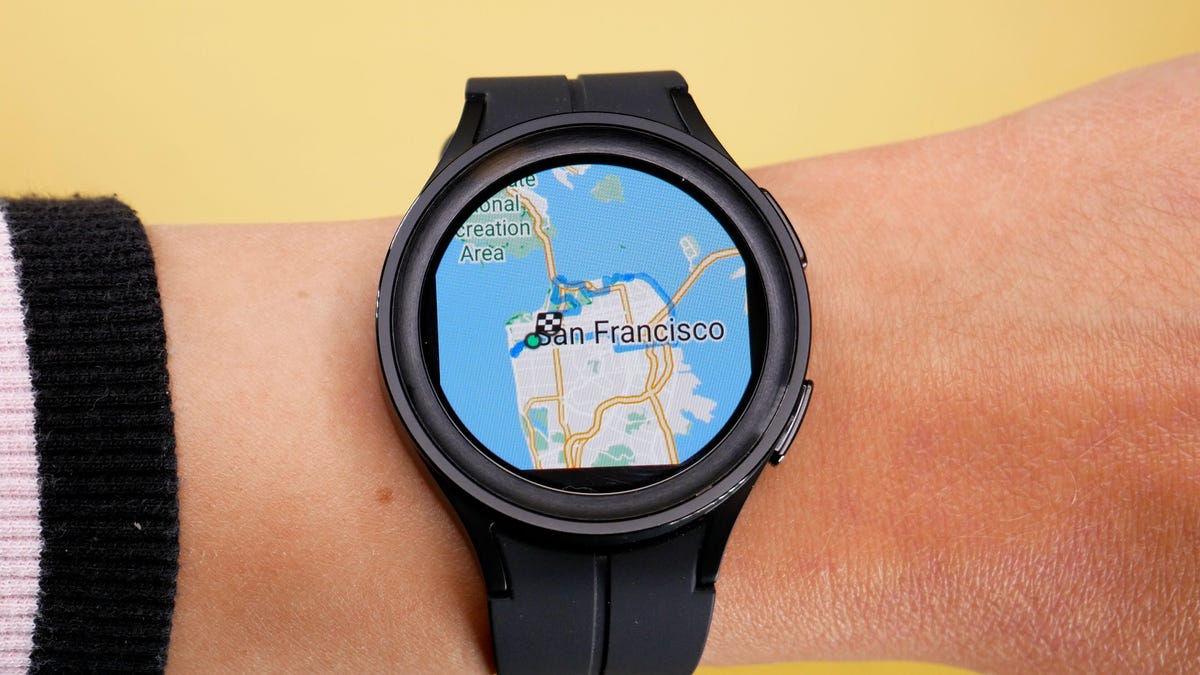
A route displayed on the Galaxy Watch 5 Pro screen.
Lexy Savvides/CNET
You can also import routes to the watch and get turn-by-turn navigation. It only works with hikes and bike rides at the moment, but it’s really easy to import a GPX file. I exported a previous ride from Strava and uploaded it to the Watch 5 Pro in seconds from the Samsung Health app. Like track back, the map (which uses Google Maps) looks great on the screen and it’s easy to view. You can also export routes you’ve done on the watch from the Samsung Health app, too.
The Samsung Health app only provides two suggested routes for cycling and hiking, just in case you don’t have any routes of your own saved yet, but they’re based in New York and London, so not super helpful if you don’t live in either of those cities. But I don’t mind because the mapping interface is cleaner and easier to read than some other sports watches I’ve used thanks to Google Maps. The watch also offers turn-by-turn navigation, which can guide you through a route with voice, vibrations and on-screen alerts.
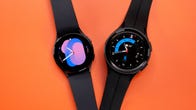
Watch this:
Galaxy Watch 5: My First 2 Days With Samsung’s Watches
9:17
Some of the track back and mapping features on this watch aren’t new to the world of dedicated running watches — even watches that cost half as much. But it doesn’t really feel like Samsung is trying to position this watch to be a replacement or direct competitor with the likes of higher-end Garmin watches anyway. If you’re a serious athlete, you’d want more in-depth analysis and features than what the Galaxy Watch 5 Pro can provide with its first-party workout apps.
Also, the always-on display is pretty dim when you’re in direct sunlight. I had to squint in a couple situations to see elapsed time or my pace, which prompted me to stop and tap the screen to wake it up to check my stats. Fortunately, I didn’t have any issues with visibility indoors or in shaded conditions.

Track back on the Galaxy Watch 5 Pro.
Lexy Savvides/CNET
Sensor accuracy is great for workouts, but temperature is TBD
I tested the Galaxy Watch 5 Pro’s optical heart rate sensor against a chest strap to see how it would fare through a range of cardio workouts.
For an outdoor bike ride, which involves extra variables like bumps in the road and more arm movement that you wouldn’t get on a stationary bike, the Galaxy Watch 5 Pro did a good job keeping close to the readings from the chest strap. There were only two small intervals during the almost 2-hour workout where it deviated slightly from the control sensor, as you can see in the chart below. For a more steady cardio walkout like a regular walk, the watch also did a good job of sticking close to the heart rate monitor. Unlike some other running watches, you can’t pair an external heart-rate monitor with the Galaxy Watch 5 Pro.
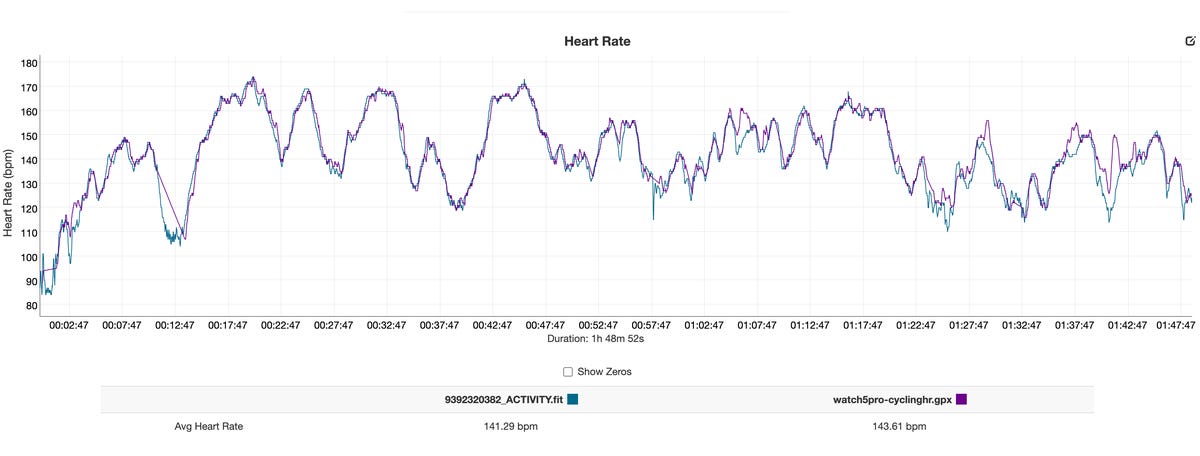
The Galaxy Watch 5 Pro (purple line) compared to a chest strap (blue line).
Lexy Savvides/CNET
GPS accuracy is really good on both Galaxy Watch 5 models. I had no issues locking on to a signal within 5 seconds in San Francisco, either with or without a phone in range.
The infrared sensor is what sets the Watch 5 series apart from last year’s models. But it’s not active yet and we don’t have an ETA on when it will get switched on via software update. Samsung says it will be used nightly while sleeping. Competitors like Fitbit and Oura use the infrared sensors on their devices for skin temperature tracking during sleep. It gives more insights into whether or not you may be running a fever, or to give insight into menstrual cycles.
This isn’t the first time a wearable has been launched without a key feature or sensor active. Fitbit’s Charge 5 launched without its key daily readiness score active, and the ECG on Samsung’s earlier Galaxy Watch 3 was unlocked about a month after launch once it received FDA clearance. I’m disappointed that we don’t have too much extra detail about how Samsung or third-party developers could use this temperature sensor yet, because it’s the main new feature of both Galaxy Watches. I hope at the very least when it does launch that it shows nightly sleep temperature trends like those other wearables I mentioned.
Most of the other health features and sensors remain largely unchanged from the Galaxy Watch 4. You still get that bioimpedance sensor to measure body composition, plus a blood oxygen sensor and ECG. But to use the ECG and blood pressure sensor (only available in select countries), you will need to pair with a Samsung Galaxy phone.

The Galaxy Watch 5 and Watch 5 Pro need a Samsung phone to use the ECG. This is what you’ll see if you pair with any other Android phone.
Lexy Savvides/CNET
I’ve had mixed results from the blood oxygen sensor, which tends to read a little lower than both a pulse oximeter and other wearables, especially at night. At times, I’ve had both the Galaxy Watch 5 and Watch 5 Pro say my lowest blood oxygen level was anywhere from 80 to 87% which is particularly low and could indicate signs of sleep conditions like sleep apnea. No other wearable has ever given me such low readings, especially when I charted the same night’s sleep with both the Fitbit Charge 5 and Oura ring. Blood oxygen sensors are generally not medically cleared, so take their readings with a grain of salt and always consult a medical professional for proper guidance. I’ve reached out to Samsung about the mysteriously low readings and will update this review when I hear back.
Recovery metrics are the missing piece of the puzzle
One of the biggest advantages of wearing a smartwatch in recent years is learning more about how your body recovers after a workout or from illness. There are limited recovery metrics available in Samsung Health and on the watch itself, including a sleep score and stress readings that don’t really tell you much beyond a scale of high, average or low. What does that mean? It’s up to you to work that out.
You can also track sweat loss after an outdoor run, plus recovery heart rate when you set body composition targets. But again, the onus is really on you to interpret this data, and the Galaxy Watch 5 Pro doesn’t go as far as the competition in making all this easy to understand.
Garmin offers the Body Battery, which takes into account heart rate variability, sleep and activity levels to determine if you can push yourself to do another workout or should take it easy. Similarly, Fitbit has the Daily Readiness Score that also gives you suggested workouts to do based on your score. Even if the Galaxy Watch 5 Pro had a recovery time metric to let you know how long your body needs between workouts, that would be better than nothing.
The biggest battery on a Galaxy Watch, but I want even more
The Galaxy Watch 5 Pro has the biggest battery from the 2022 range at 590 mAh. Samsung claims it can last up to 80 hours in total with regular use, or 20 hours with GPS. I did a 2-hour hike with airplane mode active to ensure I was using GPS-only, and the battery dropped by just 10% even with the always-on display active. That’s promising performance, and under those conditions the watch would meet the 20-hour claim with GPS alone. (I wasn’t quite ready to do a 20-hour hike to test continuous drain.)
With regular usage, including phone notifications, always-on display, sleep tracking, continuous heart rate monitoring and a 1-hour GPS workout every day, the Watch 5 Pro lasted for 2.5 full days, or a little over 58 hours. That’s better than last year’s Galaxy Watch 4 range, but nowhere near similarly priced competitors like the Garmin Venu 2 Plus, which can reach a week or more between charges. Samsung claims a maximum of 80 hours of use under normal conditions, which you might meet if you do fewer outdoor workouts and turn the always-on display off.
Fortunately, both the regular Watch 5 and Watch 5 Pro support faster charging and can reach 45% charge in 30 minutes. I tested this with the Watch 5 Pro and recharged from flat to 42% full in half an hour. It takes a little over 2 hours for the watch to fully juice up from flat. But you need a 25-watt USB-C charger to take advantage of this faster charge speed and, just like the Apple Watch, there’s no charging brick included in the box.
The Galaxy Watch 5 Pro can also take advantage of reverse wireless charging if you have a Samsung phone, but it’s tricky to get the watch to lie flat with the magnetic buckle strap, so I usually end up relying on the included charging puck.
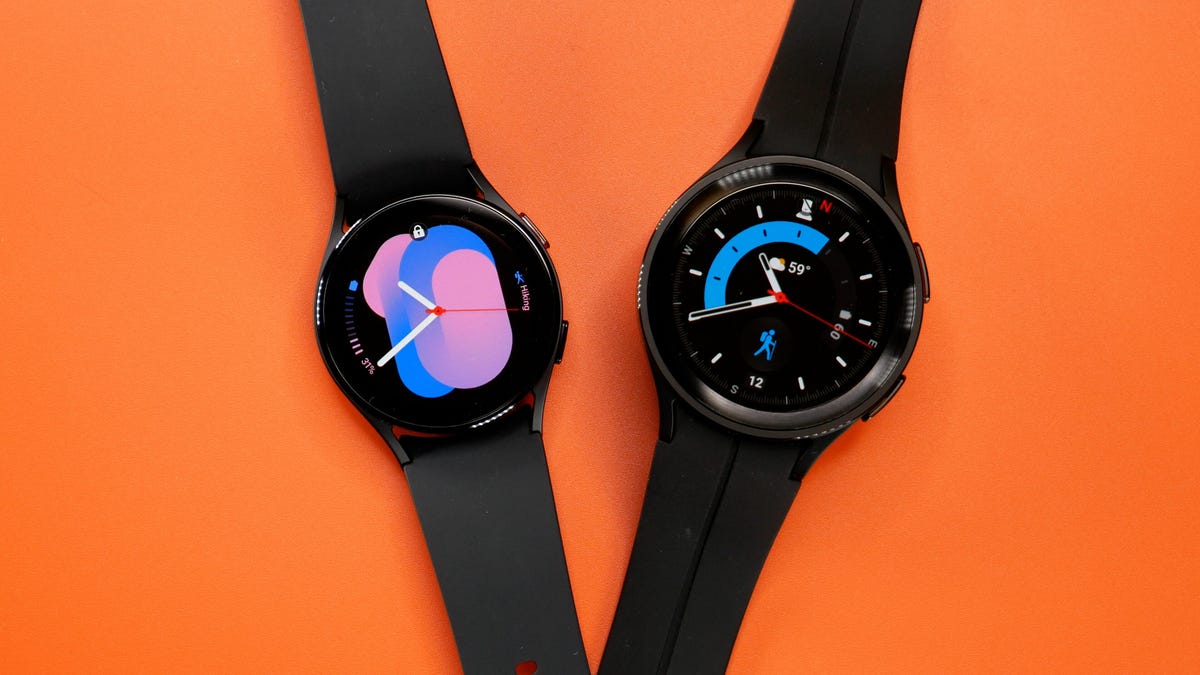
Lexy Savvides/CNET
Galaxy Watch 5 Pro: ‘Pro’ in name, almost enough in practice
Samsung has a legacy in sports watches, including the Gear range. But it feels like the company could have gone one step further in making this a true fitness watch with even more sports features. That said, this is a really strong smartwatch with a durable construction to suit casual athletes or anyone who needs a tougher wearable.
So it’s easy to recommend the Galaxy Watch 5 Pro if you’re looking for an Android watch that skews more to being a true smartwatch with a few sports features thrown in, rather than a fitness watch. I’d also pick this over the regular Galaxy Watch 5 simply because it has better battery life.
Source by www.cnet.com



























